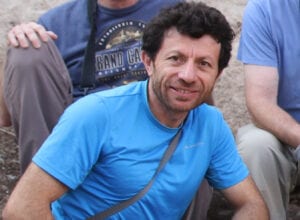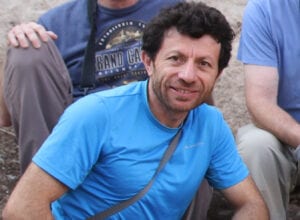
Tel Aviv University and the Hebrew University researchers make dramatic discovery in Israeli excavation: A new type of Homo unknown to science
Ramla, a mixed city of 80,000 people (three-quarters of them Jewish) near Ben-Gurion Airport, in the central district of Israel, is not known for making much news. Founded in the early 8th century CE by the Umayyad prince Sulayman ibn Abd al-Malik as the capital of Jund Filastin, the district he governed becoming caliph in 715, did have strategic and economic value because of its location at an intersection connecting Cairo with Damascus and the road connecting the Mediterranean port of Jaffa with Jerusalem. And it did suffer severe damage from earthquakes in 1033, 1068, 1070, 1546 and 1927.
But now Ramle is now definitely making the headlines because the bones of an early human (hominid) – until now unknown to science that lived in the Levant at least until 130,000 years ago – were discovered in excavations at the Nesher Ramla site, near the city. According to common practice, the new Homo fossil was named after the site where it was discovered – the Nesher Ramla Homo type. The find is considered one of the most important anthropological discoveries in the past century. Human evolution, the researchers said, is much more complicated than believed until now.
Recognizing similarity to other archaic Homo specimens from 400,000 years ago that were found in Israel and Eurasia, researchers from Tel Aviv University (TAU) and the Hebrew University of Jerusalem (HUJI) reached the conclusion that the Nesher Ramla fossils represent a unique Middle Pleistocene population that has now been identified for the first time.
According to the researchers, the morphology (form and structure) of the Nesher Ramla humans shares features with both Neanderthals (especially the teeth and jaws) and archaic Homo (specifically the skull). At the same time, this type of Homo is very unlike modern humans – displaying a completely different skull structure, no chin and very large teeth.

Dr. Yossi Zaidner (photo credit Yuval Pan)
The teams shared their find with a team of dating specialists from France (CNRS, Université Bordeaux Montaigne, National Museum of Natural History in Paris and Université Paris-Saclay) who dated them to 120,000 years ago, when Homo sapiens and Neanderthals were the only known human species roaming about Africa, Europe and the Near East.
The discovery of a new Homo group in this region, which resembles pre-Neanderthal populations in Europe, challenges the prevailing hypothesis that Neanderthals originated from Europe. This suggests that at least some of the Neanderthals’ ancestors actually came from the Levant.
Following the study’s findings, researchers believe that the Nesher Ramla Homo type is the ‘source’ population from which most humans of the Middle Pleistocene developed. In addition, they suggest that this group is the so-called ‘missing’ population that mated with Homo sapiens who arrived in the region around 200,000 years ago – about whom we know from a recent study on fossils found in the Misliya cave.
The new finding indicates that two types of Homo groups lived side by side in the Levant for more than 100,000 years (200,000 to 100,000 years ago), sharing knowledge and tool technologies. These were the Nesher Ramla people who lived in the region from around 400,000 years ago and the Homo sapiens who arrived later, some 200,000 years ago.
The researchers claim that at least some of the later Homo fossils found previously in Israel, like those unearthed in the Skhul and Qafzeh caves, do not belong to archaic (early) Homo sapiens, but rather to groups of mixed Homo sapiens and Nesher Ramla lineage.
The two Israeli research teams published their findings in the prestigious journal Science under the title “Middle Pleistocene Homo Behavior and Culture at 140,000 to 120,000 Years Ago and Interactions with Homo Sapiens.”
The TAU anthropology team was headed by Prof. Israel Hershkovitz, Dr. Hila May and Dr. Rachel Sarig from the Sackler Faculty of Medicine and the Dan David Center for Human Evolution and Biohistory Research and the Shmunis Family Anthropology Institute, situated in TAU’s Steinhardt Museum. An archaeological team at HUJI was led by Dr. Yossi Zaidner from its Institute of Archaeology.
“The discovery of a new type of Homo is of great scientific importance. It enables us to make new sense of previously found human fossils, add another piece to the puzzle of human evolution, and understand the migrations of humans in the old world. Even though they lived so long ago, in the late middle Pleistocene, the Nesher Ramla people can tell us a fascinating tale, revealing a great deal about their descendants’ evolution and way of life,” explained Hershkovitz.
“Before these new findings,” Hershkovitz added, “most researchers believed the Neanderthals to be a ‘European story’ in which small groups of Neanderthals were forced to migrate southwards to escape the spreading glaciers, with some arriving in the Land of Israel about 70,000 years ago. The Nesher Ramla fossils make us question this theory, suggesting that the ancestors of European Neanderthals lived in the Levant as early as 400,000 years ago, repeatedly migrating westward to Europe and eastward to Asia. In fact, our findings imply that the famous Neanderthals of Western Europe are only the remnants of a much larger population that lived here in the Levant – and not the other way around.”
The important human fossil was found by Zaidner during salvage excavations at the Nesher Ramla prehistoric site, in the mining area of the Nesher cement plant (owned by Len Blavatnik) near Ramla. Digging down about eight meters, the excavators found large quantities of animal bones, including horses, fallow deer and aurochs (a species of large wild cattle), as well as stone tools and human bones.
“This is an extraordinary discovery,” enthused Zaidner. “We had never imagined that alongside Homo sapiens, archaic Homo roamed the area so late in human history. The archaeological finds associated with human fossils show that “Nesher Ramla Homo” possessed advanced stone-tool production technologies and most likely interacted with the local Homo sapiens.”
The culture, way of life, and behavior of the Nesher Ramla Homo are discussed in a companion paper also published in Science.
The discovery also gives clues about a mystery in human evolution/
According to Dr. May, despite the absence of DNA in these fossils, the findings from Nesher Ramla offer a solution to a great mystery in the evolution of Homo: How did genes of Homo sapiens penetrate the Neanderthal population that presumably lived in Europe long before the arrival of Homo sapiens?
Geneticists who studied the DNA of European Neanderthals have previously suggested the existence of a Neanderthal-like population which they called the ‘missing population’ or the ‘X population’ that had mated with Homo sapiens more than 200,000 years ago, she said. The new Israeli anthropological paper suggests that the Nesher Ramla Homo type might represent this population, heretofore missing from the record of human fossils.
Moreover, the researchers propose that the humans from Nesher Ramla are not the only ones of their kind discovered in the region and that some human fossils found previously in Israel, which have baffled anthropologists for years – like the fossils from the Tabun cave (160,000 years ago), Zuttiyeh cave (250,000), and Qesem cave (400,000) – belong to the same new human group now called the Nesher Ramla Homo type.
“People think in paradigms,” commented Sarig. “That’s why efforts have been made to ascribe these fossils to known human groups like Homo sapiens, Homo erectus, Homo heidelbergensis or the Neanderthals. But now we say: No! This is a group in itself, with distinct features and characteristics. At a later stage small groups of the Nesher Ramla Homo type migrated to Europe – where they evolved into the ‘classic’ Neanderthals that we are familiar with, and also to Asia, where they became archaic populations with Neanderthal-like features. As a crossroads between Africa, Europe and Asia, the Land of Israel served as a melting pot where different human populations mixed with one another, to later spread throughout the Old World. The discovery from the Nesher Ramla site writes a new and fascinating chapter in the story of humankind.”
Prof. Gerhard Weber, an associate from Vienna University, maintained that the story of Neanderthal evolution will be told differently after this discovery: “Europe was not the exclusive refugium of Neanderthals from where they occasionally diffused into West Asia. We think that there was much more lateral exchange in Eurasia, and that the Levant is geographically a crucial starting point, or at a least bridgehead, for this process.”
“A far more sensible explanation is that through interactions, these two hominins transferred key knowledge. We still don’t know what the extent or length was of any communication or whether it was individuals meeting and interacting or there were larger social groups that came together,” he added.
Israel in the News